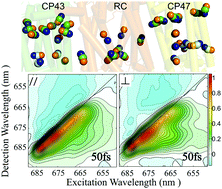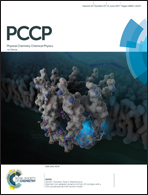Ultrafast energy transfer within the photosystem II core complex†
Abstract
We report 2D electronic spectroscopy on the photosystem II core complex (PSII CC) at 77 K under different polarization conditions. A global analysis of the high time-resolution 2D data shows rapid, sub-100 fs energy transfer within the PSII CC. It also reveals the 2D spectral signatures of slower energy equilibration processes occurring on several to hundreds of picosecond time scales that are consistent with previous work. Using a recent structure-based model of the PSII CC [Y. Shibata, S. Nishi, K. Kawakami, J. R. Shen and T. Renger, J. Am. Chem. Soc., 2013, 135, 6903], we simulate the energy transfer in the PSII CC by calculating auxiliary time-resolved fluorescence spectra. We obtain the observed sub-100 fs evolution, even though the calculated electronic energy shows almost no dynamics at early times. On the other hand, the electronic–vibrational interaction energy increases considerably over the same time period. We conclude that interactions with vibrational degrees of freedom not only induce population transfer between the excitonic states in the PSII CC, but also reshape the energy landscape of the system. We suggest that the experimentally observed ultrafast energy transfer is a signature of excitonic-polaron formation.



 Please wait while we load your content...
Please wait while we load your content...